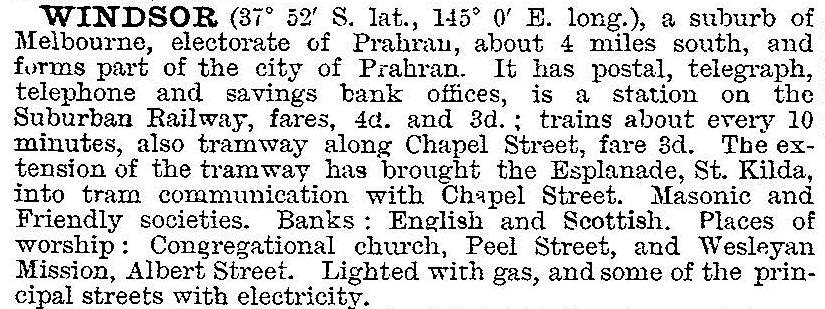Windsor
Windsor, a residential suburb south of Prahran, is 5 km south-east of Melbourne. It is bounded by High Street, St Kilda Road, Wellington Street/Dandenong Road and Williams Road on its east.
Prahran South
Windsor's area is more elevated than Prahran's and it was generally favoured for settlement. Known at first as Prahran South, it was connected by railway to Melbourne and Brighton in 1860 and by a loop line to St Kilda the year before. (The latter ceased service in 1862, and is traceable today by the linear reserve which runs into Gladstone Street.) The locality was settled with small farms and a scatter of houses and business premises. There was a Windsor Castle Hotel, from which the area's name may have originated, and the name of the railway station was changed from Chapel Street to Windsor in 1867.
Whereas the areas in the north and east of the Prahran municipality attracted merchants and villas, Windsor and the southern part of the municipality attracted residents of lesser means. The Prahran Mechanics' Institute, in High Street, Prahran South, was opened in 1856, later becoming a technical college and College of Technology. (The trades emphasis in education was continued when a new Windsor technical school, separate from the college, opened in 1971.)
A combined Protestant churches primary school was opened in 1861 and a State primary school in 1877. Its name was changed from Prahran South to Windsor in 1891. In 1873 the Presentation Sisters began Presentation College, over the road from the primary school. It is now a secondary school.
Windsor was described in the 1903 Australian handbook:

Chapel Street
Windsor is connected to the Chapel Street retailing spine. Trams were run down Chapel Street in 1888, and an extension added in 1891 to the St Kilda route. Although the giant emporia of Chapel Street were further north, the Windsor section had a solid range of drapers, footwear sellers and homewares merchants. There were several garment factories in and behind Chapel Street. Windsor's census population in 1911 was 3593.
Local churches provided clubs and meeting facilities, and were a strong element in the local social fabric. A school of domestic economy was opened in 1928 next to the primary school, attended mostly by girls of middle class means who valued domestic skills, rather than aspiring domestic workers. Modernism in the form of a picture theatre came in 1936, opposite the railway station. The station (1896) is heritage listed. Further change in the form of postwar mobility came with some shops deserting the Windsor part of Chapel Street, as fewer shoppers used train and tram services.
The Housing Commission built flats on the ground occupied by the old railway loop to St Kilda, but not as a slum reclamation project as had happened in Prahran. A decade afterwards Windsor's residences attracted renovators and persons of better than working class means. The median house price in Windsor in 1987 and 1995 was 30% above the metropolitan median.
In 1990 the Windsor primary school was kept open by the merger of the Prahran school with it. The Windsor technical school was also kept open, by the Ardoch secondary college (St Kilda) being merged with it in 1987. It became a secondary college and closed in the late 1990s.
Windsor’s census populations have been:
| census date | population |
|---|---|
| 2001 | 6093 |
| 2006 | 6393 |
| 2011 | 7069 |
At the 2011 census, Windsor’s occupied dwellings were:
| Type | % of total occupied dwellings | |
|---|---|---|
| Windsor | Victoria | |
| Separate house | 21.5 | 76.9 |
| Row house | 25.7 | 9.6 |
| Flat, unit | 52.2 | 12.9 |
Further Reading
Betty Malone, Old Windsor - the south-west corner of Prahran, Prahran Historical and Arts Society, 1989
Sally Wilde, The history of Prahran, 1925-1990, Melbourne University Press, 1993


